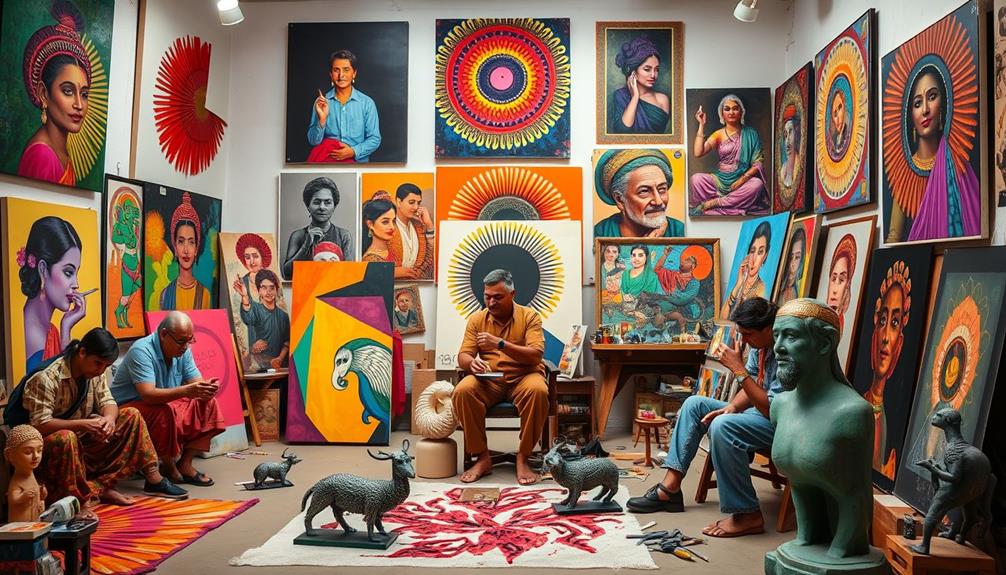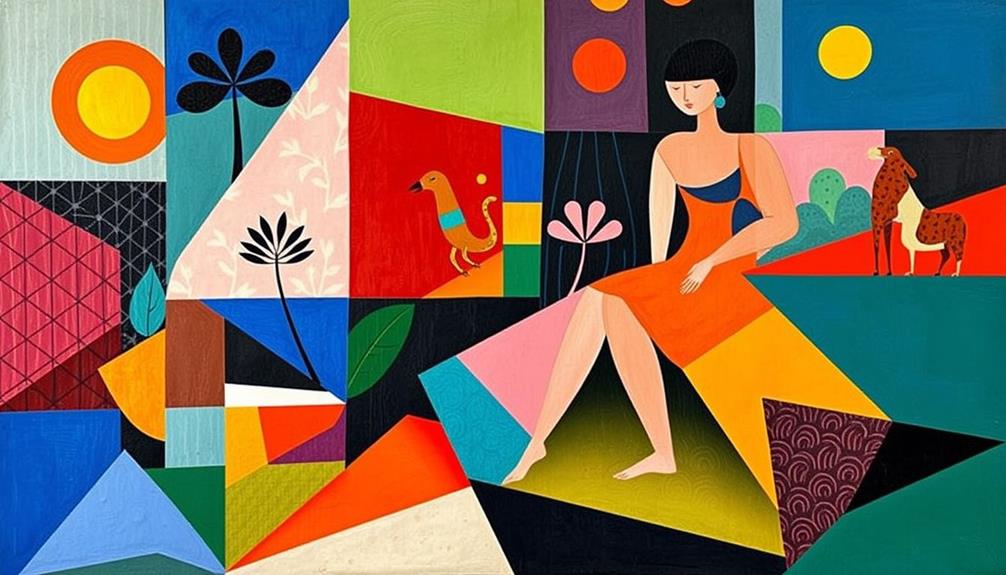If you're curious about the top contemporary artists shaping Indian art today, you'll definitely want to check out the likes of Sheela Gowda and Zarina Hashmi. Gowda's installations spark essential conversations about socio-political issues, while Hashmi's minimalist works explore themes of identity and memory. Other significant figures include Nikhil Chopra, whose performances challenge history, and Shilpa Gupta, who interrogates censorship through multimedia. Don't miss Asim Waqif's eco-conscious installations or Himali Singh Soin's thought-provoking narratives on nature. Each artist uniquely reflects India's complexities, and there's plenty more to uncover about their impactful contributions.
Key Takeaways
- Reena Saini Kallat critiques identity and migration through installations that explore bureaucratic structures, recognized internationally for her thought-provoking artwork.
- Shilpa Gupta engages with themes of censorship and freedom using multimedia installations, prompting critical discourse on political and social issues.
- Sheela Gowda's large-scale installations reflect social transformations in India, highlighting labor and human experiences through immersive art.
- Zarina Hashmi's minimalist prints address dislocation and memory, stemming from the Partition of India, resonating deeply with themes of identity and home.
- Sahej Rahal combines Indian mythology with contemporary sci-fi elements, creating playful and immersive experiences that challenge traditional narratives and conventions.
Zarina Hashmi
Zarina Hashmi, often simply referred to as Zarina, stands out as a pivotal figure in contemporary Indian art. Her minimalist monochrome prints and sculptures powerfully reflect her personal experiences of dislocation and exile, particularly stemming from the Partition of India in 1947.
In her work, you'll find a deep exploration of themes like home, identity, and memory, which resonate with many. Zarina's approach to art can be likened to the emphasis on natural materials found in modern farmhouse decor, as both invite a connection to personal and cultural narratives.
Zarina's intricate pieces often utilize materials such as paper and metal, evoking a sense of fragility and intimacy that invites you to contemplate your own connections to these themes.
In 2011, she played a significant role in India's first national pavilion at the Venice Biennale, marking an important moment in showcasing Indian contemporary art on a global stage.
Her artworks have gained recognition in major international collections, including the Guggenheim Museum and the Museum of Modern Art in New York, affirming her status as a leading artist.
In 2019, she was honored with the prestigious Padma Shri award for her contributions to the arts, further solidifying her impact on contemporary art and the exploration of identity within it.
Sheela Gowda

Sheela Gowda stands as a crucial figure in contemporary Indian art, known for her large-scale installations that utilize local materials to reflect the social and economic transformations in India. Her work, particularly the notable piece "Behold," acquired by Tate in 2014, showcases her engagement with labor and the human experience through intricate craftsmanship and found objects.
You'll notice how she draws inspiration from her surroundings, weaving elements of everyday life and traditional practices into her art, thereby creating a dialogue between contemporary and rural contexts. Additionally, much like how chia seeds offer numerous health benefits, Gowda's art serves as an essential commentary on the evolving landscape of Indian society, emphasizing the importance of cultural heritage.
Gowda's immersive installations challenge you to confront the complexities of urbanization, identity, and the cultural landscape of India. By participating in significant international exhibitions, like the Venice Biennale, she captures attention for her poignant commentary on societal issues that resonate deeply.
As you explore her work, you'll see how she transforms local materials into powerful narratives that reflect broader themes relevant to contemporary Indian artists. Through her thought-provoking installations, you're invited to reflect on the intricate relationship between art and the rapidly changing dynamics of modern India.
Raqs Media Collective

With a focus on memory, time, and social change, Raqs Media Collective has emerged as an essential force in contemporary Indian art since its founding in 1992. This interdisciplinary group of artists based in New Delhi blends media, film, and performance to engage with contemporary issues in thought-provoking ways.
Their works often reflect a deeper understanding of social dynamics, similar to how astrology claims to influence personality traits linked to attractiveness. By co-founding the Sarai Programme, they've greatly contributed to critical discourse around art and society in India.
Raqs Media Collective's innovative works often feature elements of installation and public art, inviting audience participation and fostering dialogue on complex cultural and political narratives. Notable projects like "The Last International" and "The Ghost of the Future" showcase their commitment to addressing contemporary challenges through artistic expression that resonates with viewers.
Their participation in prestigious global events, such as the Venice Biennale and the Sharjah Biennale, has further elevated their visibility within the international art scene.
Through their unique approach, Raqs Media Collective not only shapes the landscape of contemporary Indian art but also encourages you to reflect on the interconnectedness of memory, time, and social change in today's world.
Nikhil Chopra

Nikhil Chopra stands out as an essential figure in contemporary Indian art, using performance to explore themes of colonialism, identity, and the intricate layers of history. As a performance artist, he creates immersive experiences that engage audiences on both personal and collective levels. His work often incorporates elements of drawing, painting, and storytelling, reflecting the socio-political context of contemporary India.
His significant "Raghu" series embodies a fictional Indian man, traversing various landscapes and narratives. This character allows Chopra to investigate themes of memory and transformation, making his performances resonate deeply with viewers. His participation in major international exhibitions, including the Venice Biennale and the Kochi Biennale, highlights his importance in the global art scene.
| Key Themes | Notable Works | Exhibition Highlights |
|---|---|---|
| Colonialism | "Raghu" Series | Venice Biennale |
| Identity | Live Art Performances | Kochi Biennale |
| Memory & Transformation | Multimedia Installations | International Exhibitions |
Through his thought-provoking performances, Chopra challenges the audience to confront their own perceptions of history and identity in today's world.
Shilpa Gupta
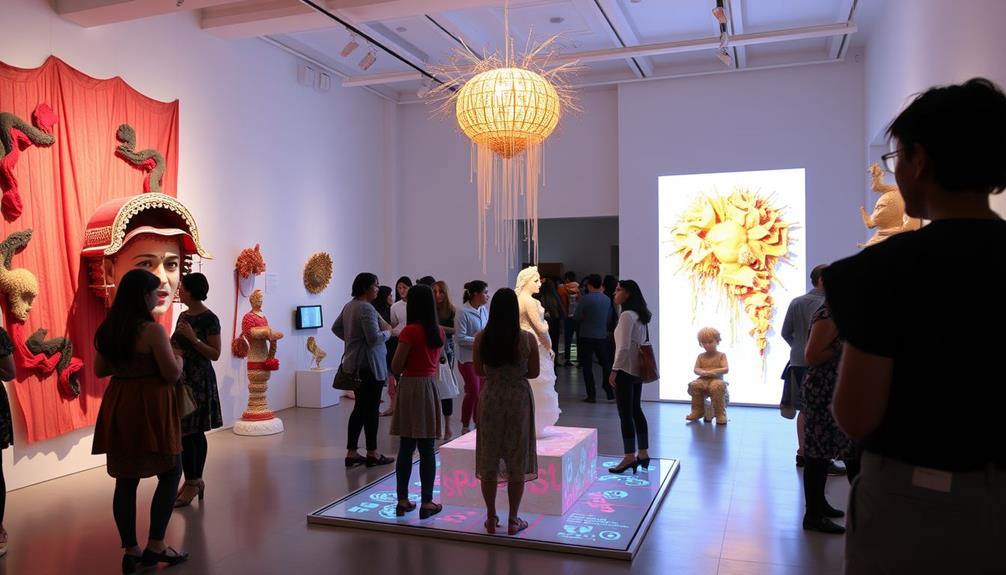
Exploring the complexities of contemporary Indian art further, Shilpa Gupta emerges as a prominent voice renowned for her multimedia works that probe themes of knowledge, perception, and censorship. Her art often intersects with political discourse, raising critical questions about freedom and expression.
This engagement with societal issues resonates with the concept of quorum sensing in bacteria, illustrating how communication and coordination can influence broader outcomes. A standout piece from the Venice Biennale in 2019 showcased a striking installation featuring prison bars accompanied by a haunting soundscape of imprisoned poets, powerfully illustrating the impact of state control on artistic freedom.
Gupta's use of various mediums—video, sound, and installation—invites you to engage with her work on multiple levels. By incorporating everyday materials and interactive components, she encourages you to reflect on your perceptions and the societal issues at play.
Her ability to weave together personal and political narratives makes her contributions crucial in the landscape of contemporary Indian art. Exhibiting internationally, Shilpa Gupta has sparked essential discussions about the relevance of Indian art in a global context.
Her works not only challenge norms but also inspire dialogue, compelling you to contemplate the implications of censorship and the power of expression in today's world.
Reena Saini Kallat

Reena Saini Kallat's work captures the complexities of identity and migration, pushing you to contemplate how these themes resonate in today's world.
Her innovative use of diverse media, similar to the way Stain Art transforms imperfections into beauty, creates a rich tapestry that reflects cultural memory and personal histories.
As you explore her art, you'll find a compelling commentary on the fluid nature of borders and the experiences that shape our identities.
Identity and Migration Themes
Identity and migration are intricately woven into the fabric of Reena Saini Kallat's artwork, offering a profound commentary on the human experience. Through her work, you'll find a sharp critique of the bureaucratic structures that govern personal lives, revealing how these systems impact individual identities.
In her series "Leaking Lines," Kallat visually captures the fluidity and complexities of borders, encouraging you to reflect on the socio-political implications of migration in contemporary society. This theme resonates with the idea that small mistakes, such as miscommunication about identity, can lead to significant consequences in personal narratives and societal structures, highlighting the importance of awareness and reflection to enhance decision-making.
Her use of diverse media—painting, sculpture, and installation—creates multifaceted narratives that resonate with both personal and collective histories. You can see how Kallat employs organic materials like paper and textiles, symbolizing the fragility of human experiences and the interconnectedness of identity amidst the challenges of migration.
Each piece tells a story, inviting you to engage with the complexities of displacement and cultural identity.
Through significant exhibitions, including the Venice Biennale, Kallat's work has gained international recognition, highlighting how identity and migration are pressing issues in our contemporary world. Her art not only reflects these themes but also encourages a deeper understanding of the human condition.
Diverse Media Exploration
Through a vibrant mix of painting, sculpture, and installation art, Reena Saini Kallat explores themes of cultural memory and identity. Her innovative approach uses diverse media to challenge and engage with the complexities of contemporary practices in India. Kallat's ability to evoke emotional responses through her art is reminiscent of how cats exhibit attachment to their owners, highlighting a deep connection to identity and belonging signs of attachment in cats.
You'll find her work deeply layered, often incorporating found objects and materials to emphasize her narratives.
- Combines traditional art techniques with modern elements
- Addresses migration and displacement through her series "Leaking Lines"
- Critiques bureaucratic systems using symbols like maps and stamps
- Reflects on borders and geopolitical realities of contemporary India
Kallat's art invites you to ponder the fluidity of cultural identities. By showcasing her pieces in prominent venues like the Venice Biennale and the Museum of Modern Art in New York, she demonstrates a global resonance that transcends geographical boundaries.
Her commitment to exploring social narratives through various mediums not only enriches the Indian art scene but also encourages viewers to reflect on their own experiences within a diverse cultural landscape. Kallat's work embodies the dynamic interplay of art and identity, making her a pivotal figure in the new generation of Indian artists.
Cultural Memory Representation
Artistic practices in contemporary India often intertwine with the representation of cultural memory, and Kallat is a master at this intersection. Through her diverse media, including installation and sculpture, you'll find her work deeply engaging with identity and collective histories. In her recent series "Leaking Lines," she critiques the state apparatus, incorporating bureaucratic symbols that reflect the complexities of migration.
Kallat's installations draw on her personal experiences while addressing broader socio-political contexts, showcasing the impact of globalization and displacement. Her innovative use of materials, often repurposed, challenges you to reconsider cultural memory and its representations.
Here's a summary of her key themes:
| Theme | Description | Example |
|---|---|---|
| Cultural Memory | Exploration of shared histories | "Leaking Lines" |
| Identity | Reflection on individual and collective identity | Use of bureaucratic symbols |
| Installation | Thought-provoking repurposed objects | Large-scale installations |
| Global Influence | Participation in international exhibitions | Venice Biennale |
| Socio-Political Context | Commentary on contemporary issues | Engagement with migration narratives |
Kallat's work powerfully illustrates how art can shape our understanding of cultural memory.
Thukral & Tagra

In the domain of contemporary Indian art, the duo Thukral & Tagra stands out for their dynamic blend of creativity and social commentary. This innovative partnership, consisting of Jiten Thukral and Sumir Tagra, explores themes of migration and globalization through their vibrant installations and sculptures. They engage audiences by merging traditional Indian aesthetics with contemporary visual culture, creating a unique dialogue around pressing social issues. Their approach resonates with the growing trend of incorporating AI-generated music into artistic expressions, further bridging the gap between technology and art.
- Their work often features playful elements and bold colors.
- They've showcased at prestigious venues like the Venice Biennale.
- Everyday objects are transformed into thought-provoking art pieces.
- They leverage art as a tool for social commentary.
As leading Indian contemporary artists, Thukral & Tagra challenge conventional narratives surrounding identity and consumerism. Their installations invite you to reflect on the complexities of modern life, making you rethink how art intersects with daily experiences.
Sahej Rahal
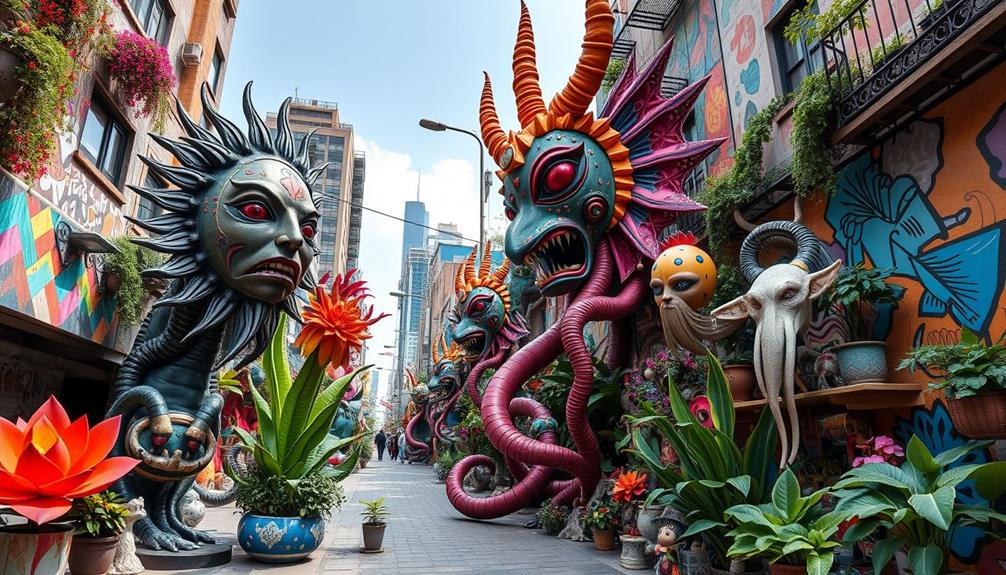
Sahej Rahal's artistic practice transports you to mythical worlds where Indian mythology meets science fiction. By blending various mediums, he challenges cultural narratives and explores identity in playful yet profound ways.
His innovative approach is akin to how AI improves diagnostic accuracy in healthcare, as he utilizes technology to enhance storytelling. As you engage with his installations and performances, you'll see how he reshapes storytelling through an interdisciplinary lens.
Mythical Worlds Creation
Creating immersive mythical worlds, Sahej Rahal invites you to explore a fascinating blend of Indian legends and contemporary science fiction. His work transcends traditional boundaries, merging performances, sculptures, and films that engage you in a dialogue about modern existence, much like how play enhances cognitive development in children by fostering creativity and imagination.
- Experience themes of migration and cultural identity
- Discover humor and playfulness in serious narratives
- Engage with interactive art that challenges conventions
- Witness his unique approach showcased at major exhibitions
Through Rahal's lens, mythical worlds become a canvas where the complexities of belonging and identity are examined. He masterfully incorporates elements of fantasy to reflect realities we face today.
You're not just a spectator; you're part of the narrative, encouraged to reflect on your own experiences.
Rahal's artistic practice resonates in today's globalized context, making his contemporary art relevant and thought-provoking. As you step into his creations, you'll find yourself questioning the nature of identity and migration, all while being captivated by the playful essence of his storytelling.
Sahej Rahal is indeed a crucial force in shaping the new generation of Indian art, inviting you to rethink and redefine your understanding of mythical worlds.
Interdisciplinary Artistic Practice
Interdisciplinary artistic practice defines Sahej Rahal's approach to art, seamlessly blending elements of mythology, anime, and science fiction. You'll find his works aren't just traditional paintings; they encompass performance, sculpture, and film, creating immersive experiences that challenge your perceptions.
By integrating these diverse mediums, Rahal invites you into a mythical world where storytelling takes on new dimensions. His unique practice allows him to explore cultural identity in innovative ways, merging traditional Indian narratives with contemporary forms.
As you engage with his art, you'll notice how it reflects the dynamic evolution of Indian art in the 21st century. Each piece serves as a bridge between the past and the present, asking you to reconsider the complexities of cultural identity in a modern context.
Rahal's participation in international exhibitions, like the Kochi Biennale, further amplifies his voice on the global stage. Through this interdisciplinary artistic practice, he not only showcases his work but also contributes to a broader conversation about the role of mythology and contemporary themes in shaping today's art landscape.
You'll leave with a deeper understanding of how these elements intertwine in the fabric of modern Indian art.
Cultural Narratives Exploration
Exploring cultural narratives is at the heart of Sahej Rahal's artistic vision. He masterfully blends Indian mythology with contemporary themes, crafting a unique dialogue that resonates with audiences today. By reinterpreting traditional narratives, he examines the complexities of cultural identity in an increasingly globalized world.
- Large-scale installations that immerse viewers in mythic experiences
- Incorporation of anime and science fiction elements for a modern twist
- Use of unconventional materials and techniques pushing artistic boundaries
- Participation in prestigious events like the Kochi Biennale
Rahal's work invites you to engage deeply, challenging you to reflect on how age-old stories can find relevance in modern contexts. His innovative expressions encourage a rethinking of cultural identity, illustrating how traditional narratives can evolve without losing their essence.
Asim Waqif

Asim Waqif frequently captivates audiences with his innovative use of waste materials, transforming them into large-scale installations that challenge our perceptions of art and sustainability. His work dives deep into themes of ecology, urging you to rethink the relationship between humans and the environment. Through these installations, Waqif reflects on the impact of urbanization and climate change, making you confront the pressing issues our planet faces today.
Integrating architecture and design, Waqif adopts a multidisciplinary approach that enriches the viewer's experience. His projects often invite participation, creating immersive environments that engage you in critical discussions about sustainability and the future of urban spaces. By doing so, he doesn't just create art; he fosters a dialogue about the necessity of environmental activism.
Exhibiting internationally, Waqif's unique ability to blend art with social commentary has gained him recognition as a leading contemporary artist. His installations serve as a reminder of the waste we produce and the ecological footprint we leave behind.
In this way, Asim Waqif not only shapes the contemporary art scene but also inspires a new generation to think critically about sustainability and our role in it.
Himali Singh Soin
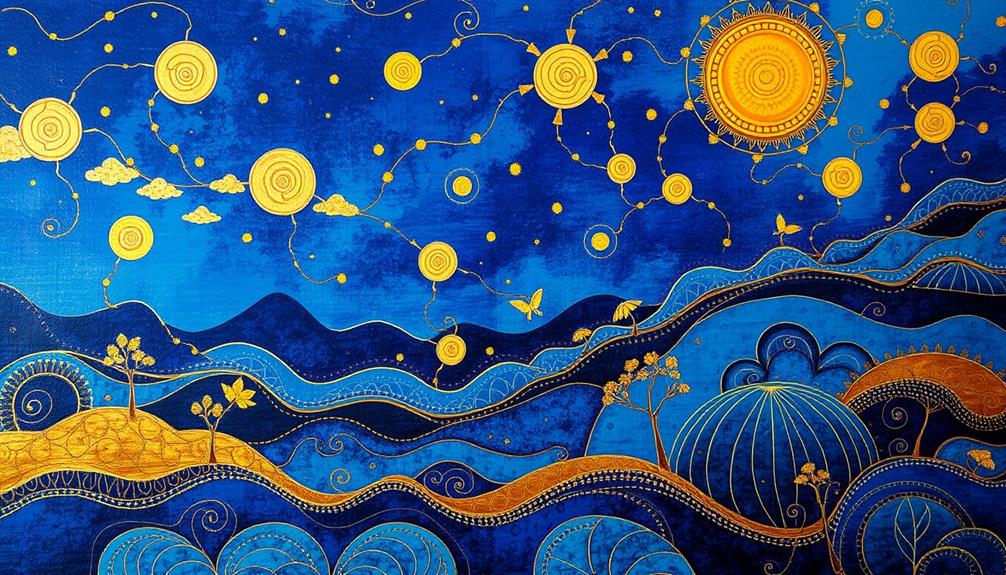
With an enchanting blend of performance, film, and installation, Himali Singh Soin immerses viewers in evocative narratives that examine our connection to the natural world. Her work is a powerful exploration of ecology, climate change, and human interaction with nature, particularly through the lens of Arctic and Antarctic narratives.
- Awarded the Frieze Artist Award in 2021
- Featured in prestigious exhibitions like the Kochi Biennale
- Engages audiences with complex stories about sustainability
- A significant voice among contemporary artists shaping Indian art
Singh Soin's artistic practice creates immersive experiences that challenge traditional boundaries. She emphasizes storytelling, allowing audiences to engage deeply with pressing environmental issues.
By weaving together personal and collective narratives, she provokes dialogue about our relationship with the environment. Her innovative approach not only highlights her noteworthy contributions to contemporary art but also positions her as a essential figure in the new generation of Indian artists.
Through her work, you're invited to reflect on the delicate balance between humanity and nature, making her an important artist in today's discourse on ecology.
Frequently Asked Questions
Which of These Contemporary Indian Artists Is Renowned?
You're looking for renowned contemporary Indian artists. Zarina Hashmi and Bharti Kher stand out with their distinctive styles and impactful themes, while Sheela Gowda and Shilpa Gupta also gain recognition for their thought-provoking installations and multimedia works.
Who Is the Indian Famous Modern Artist?
When you think of famous modern artists in India, you can't overlook M. F. Husain, Amrita Sher-Gil, and S. H. Raza. Their unique styles and profound influences have shaped the landscape of Indian art considerably.
Who Is the Indian Artist Who Has Brought Indian Contemporary Art Onto the World Stage?
You might consider M. F. Husain, who brought Indian contemporary art onto the world stage. His unique blend of Cubism and traditional themes reshaped perceptions, making a lasting impact through numerous international exhibitions and acclaim.
Who Is the Father of Modern Indian Art?
Isn't it fascinating how one person can change an entire artistic landscape? Raja Ravi Varma's mastery and innovative spirit make him the father of modern Indian art, blending tradition with modernity in profound ways.
Conclusion
As you explore the vibrant world of contemporary Indian art, you'll discover a rich tapestry woven by these ten remarkable artists. Each one breathes life into their work, challenging perceptions and igniting conversations. From the intricate shadows of Zarina Hashmi to the bold expressions of Shilpa Gupta, their creativity sparks a dazzling fire in the landscape of modern art. Embrace this journey, and let their visions inspire you to see the world through a fresh lens.
